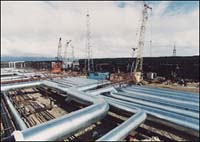 GAS - HOLDING ON TO THE MONOPOLY
GAS - HOLDING ON TO THE MONOPOLY |
The gas industry is the only industry that has
managed to escape cardinal changes in its organizational
structure. The incumbent, Gazprom, controls over
90 percent of gas extraction and marketing, the
entirety of trunk-line transport and almost total
gas export from Russia. Indeed, the Russian economy
cannot be understood without taking into account
Russian gas. The discussion on the liberalisation
of the local gas market has therefore incredible
significance.

The reform debate focuses on the problems and
ways of organizing the trade in gas. Non-discriminating
access to the gas transportation system are being
proposed to remedy the situation and to develop
the gas market in Russia. The Ministry for Economic
Development and Trade wants to do away with Gazprom's
pipeline interests, and transfer them into subsidiaries
that would be 100% owned by Gazprom, under tight
government control. Gazprom has objected to this
idea saying that a free domestic market needs
to be established before independent producers
are allowed to compete with the company at home
and abroad. The company sees a distinct disadvantage
in having to sell below cost to domestic users
while private producers are under no such obligation.
Importantly, Russia's largest tax payer has been
supplying the local market below cost at $16.40
per 1.000 cubic meters, around one sixth of gas
prices in Europe. Gazprom indicated that the company
needs to sell at $30-40 per 1.000 cubic metres
just to be able to break even. The Ministry's
basic intention is to safeguard domestic tariffs
that will be economically justified, i.e. a 20%
price increase, whereas Gazprom is looking for
a 40% increase. The incumbent resists the idea
of allowing independent producers to export at
higher prices than Gazprom's domestic sales.
Recently, the Russian gas giant announced that
it will freeze annual production for the next
27 years, after a slight increase in 2003, to
be able to back away from current loss-making
domestic sales. With gas exports rising 3.7% between
January and October 2002, the company seeks to
concentrate on the more lucrative foreign markets.
The importance of Russian gas to foreign markets
is obvious with 23% of world output coming from
Gazprom. The World Energy Council estimates Russia's
share in the international gas trade to total
30-35% by the year 2020.
|
Under long term contracts
covering 2.6 trillion cubic meters, Gazprom supplies
130 billion cubic meters of gas each year to the
European Union, which wants to see an increase in
competition through the development of short-term
spot markets. But, because natural gas production
is decreasing in Europe, and there is no real source
of natural gas in Europe except in Russia, the country
remains of the utmost importance to Europe.
The top export markets for Gazprom are hereby
Germany, Italy and France, but the United States,
vying to reduce its reliance on the conflict ridden
Middle East oil and gas supplies, is also seeking
an increase in Russia role as an energy supplier.
Gazprom has been in talks with top US companies
about a $1.5 billion plant to produce liquid natural
gas for sale to the United States.
What ensures Gazprom's effective integration into
the world gas market is the recently set up network
of its foreign economic enterprises engaged in
the direct sale of Russian gas. The liberalization
of gas markets requires a more flexible export
policy on the part of Gazprom. In particular,
this increases the significance of the development
of the Yamal-Europe gas transporting system. Furthermore,
the construction of a North European gas pipeline
across the Baltic countries is finally getting
underway. The project, which links directly Russian
and European gas transport networks, will increase
the gas giant's reliability and efficiency of
gas deliveries, improve conditions for gas sales
in Germany, facilitate entry into the Belgian
market and in future, through the so-called 'Interconnector'
system, also to that of Britain. But, along with
the traditional direction of Gazprom's exports,
the company is seeking to develop southward as
well. The most interesting project in this respect
is the Blue Stream project that involves the construction
of a gas pipeline across the Black Sea to Turkey.
Indeed, Gazprom is becoming more involved abroad,
but is also increasingly letting foreign investor
into the company. The state still holds a 38.37%
stake in Gazprom, whereas foreign entities acquired
a 10.31% share. The domestic shares value Gazprom
at roughly $18.9 billion. Russia's biggest company
(which diversified into non-profile activities,
such as metallurgy, agriculture, the hotel-business,
and banking), however, has said that it wants
to boost its market capitalization by letting
foreign investors buy as much as 40% per cent
of Gazprom. The Company's securities portfolio
consists of shares and bonds. To get to the international
financial market Gazprom issued derivatives for
its shares, i.e. American Depository Receipts
(ADRs). Interesting to institutional investors
will be that Gazprom planned to place a $750-million
(preliminary estimate) Eurobond issue under Rule
144A on the US market in the first quarter of
2003. The company previously placed an issue of
seven-year Eurobonds of $500 million in October,
2002, and a five-year $500 million issue in April,
2002.
|

